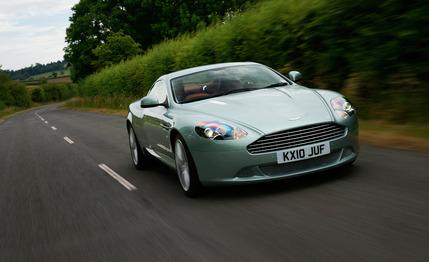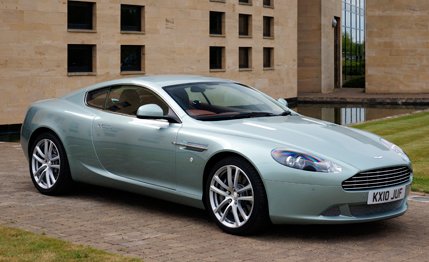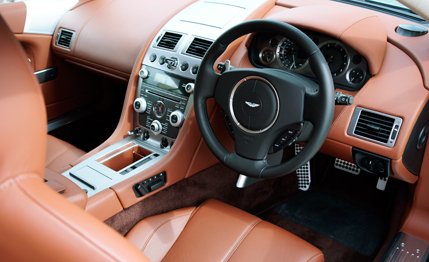 First Drive Review
First Drive Review
Let Ulrich Bez, the German engineer commissioned by Ford to transform tiny Aston Martin into a serious car company, explain the character of his new DB9.
"There is room for Aston Martin to drive a wedge between sports cars like the [Ferrari] 360 Modena and GT models like the [Bentley] Continental," he says.
After a day hammering the DB9 around the hills above Nice, France, it's hard not to agree with the passionate Bez, a rare automotive CEO who's as happy describing his steering philosophy ("As weighting increases away from the center point, I want to feel side forces in the steering") as he is talking about Aston's financial situation ("We are currently breaking even operationally and will be profitable in 2005").
Bez has every reason to be optimistic. With parent company Ford opening its wallet wide, Aston developed a flexible new platform—known internally as VH, for "vertical horizontal"—that is the basis for the DB9, in addition to next year's smaller V-8 Vantage and the 2007 replacement for the Vanquish. If the earlier car, the DB7, could plead that it was severely compromised by its archaic XJS Jaguar platform (from 1975), there can be no excuses for the DB9 in its pursuit of a 2265-cars-a-year niche that blends sports car with GT.
Apart from retaining the Aston's V-12 engine—even though it's thoroughly revised via a new crank, cams, manifold, and engine-management system for more midrange torque—the engineers' clean-sheet game plan called for an all-new structure. They wanted 50/50 weight distribution, so they set the 444-hp V-12 well back in the engine bay, adopted a transaxle layout for the ZF six-speed automatic (you could pay more for the six-speed manual Graziano next year; the firm supplies Ferrari), and developed a bonded aluminum platform that's a mix of extruded, stamped, and die-cast parts. The front fenders and hood are composite, but the rest of the exterior skin is aluminum.

It's achingly beautiful. Aston found no reason to start a styling revolution. The DB9, like the Vanquish, DB7, and V-8 Vantage, relies on classic proportions, long-established Aston styling cues, big 19-inch wheels, and simple sculptured forms to achieve its gorgeous looks. Less visually aggressive and more elegant than the $235,600 460-hp Vanquish, the DB9 will launch this month with the $155,000 coupe, and a couple of months later, the $170,000 Volante convertible will follow.
Happily, the DB9 driving experience matches the beauty. A welcome 5.8-inch stretch of the wheelbase means this is the first modern Aston to offer a respectably roomy driving position, with ample adjustment for the deep buckets and lovely leather steering wheel. If the rear seats remain token gestures at best, here at last is an Aston with a distinctive, special-place interior that's dominated by a sweeping central band of bamboo timber, 3-D aluminum instruments, and the rich smell of cowhide.
The first critical decision for the driver is to choose between changing gears manually via the steering-wheel paddles and selecting automatic "drive." For the DB9, ZF has doctored its familiar automatic, here called Touchtronic 2, so that it can perform like the electrohydraulic shift of the clutch-pedalless manual gearbox used in the Vanquish. It blips the throttle on downshifts and swaps gears the instant either the upshift or downshift paddle is activated. In contrast to drive modes that slide into the next gear at 6500 rpm, Touchtronic 2 refuses to upshift, even when the howling V-12 hits the soft 6900-rpm cutout in sport mode.

Aston's latest luxury vehicle rides more firmly than the earlier car, the DB7, especially at low speeds, but rewards the driver with far better control and agility. It stays flat through a series of corners, rarely unsettling the suspension over bumps, and encourages fast driving. If that's the trade-off for a ride that is clearly biased toward the firm, so be it. At the behest of Bez, the steering is heavy, but as cornering loads increase, the dead sensation at low speeds is replaced by genuine feel (there's even occasional kickback), and the handling becomes responsive. Getting the DB9 to wag its tail demands real commitment on dry roads; more to the point, a hooligan driving style doesn't suit the Aston character.
In an era when Mercedes-Benz's tuning arm, AMG, has redefined acceleration, the DB9's blueprint of 444 horses pushing around as much as 3900 pounds is comparatively modest; that is, if the claimed 0-to-60 number of 4.9 seconds—the manual does it in 4.7 seconds—can be considered modest. More crucial, the DB9 always feels quick, the power building from 3500 rpm and hitting its sweet spot between 5500 and 6000 rpm, the optimal change-up point for the best acceleration numbers.
No longer does the DB Aston live by beauty alone. This is the best-sorted, most thoroughly engineered Aston Martin of all time. Still, exquisite appearance remains central to its appeal. Combine this with a superb interior and authentic dynamic allure, and Bez's rationale stands up.